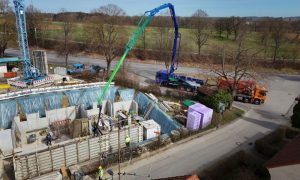Gaining control over project costs and risk
Tight oil and gas discoveries, in North America and worldwide, have launched a major realignment of oil and gas supply dynamics, decoupling of oil and gas prices, and a resulting growing demand for major capital assets, which has also had a heavy impact on the Middle East market. This is creating an increase in E&C backlogs worldwide and a bright outlook for the E&C industry.1 One of the biggest factors that may disrupt these capital projects is a chronic escalation of project capital costs.2
According to a PwC survey of the Capital Projects market in the Middle East, “80% of respondents said that their projects had experienced a delay, with 46% saying that they had suffered significant delays – in excess of six months. Completing projects on budget was also a significant issue, with only 36% of respondents saying that their projects were completed on or under budget.”3
New thinking is required to overcome project cost and execution challenges. Early and accurate cost estimates are vital to reducing project risk for both E&Cs and owner-operators. Alignment of project scope and estimate are crucial to overall management of project capital expenditures. How can this be achieved?
One of the earliest and most important areas of communication between the E&C and the owner- operator is around the project scope. A challenge at this stage of a project is the financial, business and resource pressure, which causes engineering teams to begin detailed design before FEED has been completed and before the scope has been locked down. This causes wasted engineering effort on the one hand and project cost fluidity on the other. More focus on higher quality FEED at this stage of a project will pay off in many ways.
Another challenge is the dependence of traditional estimating groups on enumeration of bulk quantities, which usually comes out of detailed design activities, such as P&ID and 3D model development. The modern estimating group must decouple these concepts. It is completely possible today to achieve an accurate FEED (+/-15%) estimate with only 20% of the engineering work completed and mainly based on the list of major equipment items.
The use of cutting-edge economic estimation and FEED deliverables software dramatically improves engineering projects by improving scope communication early in the project, providing flexibility to contend with conceptual engineering changes and by reducing project risk and uncertainty. Based on engineering model scope definitions of process, these software tools can accurately predict total installed costs of a project within a 10-15% envelope; easily evaluate additions or subtractions of scope; and compare costs based on project relocation and assess alternatives, such as on-site fabrication version modular remote construction. The software provides a consistent cost basis to add detail progressively from pre-feasibility through construction within one system.
Adopting best practice
Projects that have achieved superior cost results generally share a number of characteristics:
(1) Use of the same software between the owner- operator and E&C, especially when employed with a transparent software system, so that scope and resource requirements are clearly communicated between owner-operator and E&C. The owner uses this to evaluate bids on an apples-to-apples basis and ensures that all requested scope is included
(2) Use of an estimating system that can be integrated with the process modelling environment and FEED deliverables software. This approach enables rapid re-evaluation of the estimate based on conceptual engineering changes, ensuring project change management consistency
(3) Use of the same estimating platform from pre-feasibility through detailed estimating. This approach can help improve estimator productivity by up to 80%
Cutting-edge economic estimation software can easily handle environmental differences (from a civil engineering viewpoint), multiple contractor cost structures, subcontractors, varyinglabour efficiencies, multiple estimating teams, modular construction and many other factors.
There are also special requirements in developingestimates on mega projects, such as offshore projects, LNG and large greenfield projects. These include the raw size of the project that must be modelled in software, both in terms of equipment and bulk sizes, as well as the number of individual cost elements, the need to split the estimate among multiple estimating teams and integration with project management systems.
Engineering software, offering an integrated lifecycle solution from conceptual design to plant start-up and operations support, enables engineers to model, build and operate safer, competitive and more reliable process plants. Companies are able to reduce capital and operating costs, increase engineering efficiency and quality, and accelerate time-to-market with payback in months instead of years. Many companies have adopted economic evaluation software tools to enable rapid evaluation of capital investment projects early in the design process and carry the estimate through from prefeasibility to construction, to improve estimating productivity and reduce variability in the estimating function. For example, Aspen Capital Cost Estimator (ACCE), part of AspenTech’s Engineering software, is a model-based estimating system that captures engineering knowledge through an ‘engineer in a box’ approach. The software is used for the estimation of capital projects of any size across the process industries, for both conceptual and detailed estimating.
Leveraging built-in engineering models and cost data that is updated yearly, ACCE provides the industry with accurate and comprehensive information for capital project scope development and costing. This includes scenarios such as relocating the proposed facility from one site to another and determining the viability of bringing new products to market. Purely dependent on an input of an equipment list, the estimates generated by the software are based on information that covers the cost of new equipment that is part of a new process, and plant bulks and civil infrastructure like piping, instrumentation and site work, along with labour for the associated design and construction activities and required resources.
To illustrate the effectiveness of such tools, the $20bn Sadara project in the Middle East successfully used Aspen Economic Evaluation software for the conceptual FEED estimate, an estimating effort split among five estimating teams. Capital cost estimating software delivers accurate and reliable results. It:
• Maximises the company’s use of capital and reduces project risk by increasing predictability of estimates and providing estimates for authorisation-for-expenditure (AFE) earlier in the engineering process
• Obtains conceptual Engineering, Procurement, Construction (EPC) estimate, once the scope is defined, in a fraction of the time required by traditional methods, reducing bidding risk and more effectively using estimators’ time
• Brings forward the capital decision timeline
• Delivers accurate and predictable cost estimates within 10-15% of actual costs
• Provides standardised information communicated across the organisation
• Increases capital project throughput while keeping the same staff levels
The value of effective decision-making
An informed understanding of the economics associated with engineering alternatives improves the conceptual design process. These include important choices about technology, yield, configuration, energy use, feedstocks and project timing. The impact of conceptual design choices on plant economics is long-lasting.
By using one economic evaluation software platform throughout the engineering cycle, the E&C progresses the estimate from feasibility to conceptual to detailed cost estimates over the project lifecycle. The value of this approach is that the estimator can focus on the major equipment items that contribute significantly to the costs, rather than spend time enumerating bulk quantities at the FEED stage. When the same software is used transparently by both the owner and the engineer, communication on project scope and control is clear and consistent. Broader understanding and adoption of this advanced estimating approach enables project decision-makers to rapidly and confidently evaluate capital investment projects early on. Reducing project uncertainty and risk can be achieved by providing project managers with the tools and capability to better hold industry capital costs in check.
Ron Beck is engineering director, AspenTech.
REFERENCES
(1) – Jorge Leis, Bain & Co, 2014, at the Rice Global E&C Forum
(2) – John Westwood, Douglas-Westwood, 2014, at the Offshore
Technology Conference
(3) – PWC – Delivering the Middle East’s Mega Projects 2012
Capital Projects and Infrastructure Survey



















